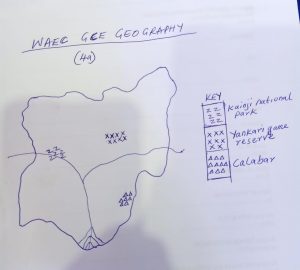
GEOGRAPHY
01-10: DBCADBCAAD
11-20: DBDBCDBDAB
21-30: BCDAACDDBC
31-40: DCCAABDDBC
41-50: BDAABCDBBC
Completed ✅
WAEC GCE GEOGRAPHY


*NUMBER ONE*
(1a)
(i) Agricultural products , Example: Coffee beans
(ii) Manufactured goods, Example: Textiles
(1b)
(PICK ANY FOUR)
(i) Access to foreign markets: International trade allows developing countries to expand their markets beyond domestic borders and access new customers and markets.
(ii) Economic growth: Trade can stimulate economic growth by creating new opportunities for employment, investment, and innovation.
(iii) Diversification of the economy: International trade allows countries to diversify their sources of income by trading different types of goods and services.
(iv) Acquisition of technology and know-how: Trade provides developing countries with the opportunity to acquire advanced technology and knowledge from more developed nations.
(v) Specialization: International trade enables countries to specialize in the production of goods and services in which they have a comparative advantage, leading to increased efficiency and productivity.
(vi) Foreign exchange: Trade allows countries to earn foreign exchange by exporting goods and services, which can be used to finance imports, investment, and development.
(1c)
(PICK ANY FOUR)
(i) Limited infrastructure: Developing countries often face challenges related to inadequate transportation, communication, and energy infrastructure, which can hinder trade activities.
(ii) Trade barriers and protectionism: Developing countries may face barriers to their exports in the form of tariffs, quotas, and non-tariff barriers, imposed by more developed countries.
(iii) Lack of access to finance: Limited access to finance and credit can hamper the ability of developing countries to engage in international trade.
(iv) Political instability and corruption: Political instability and corruption can create an unfavorable business environment, discouraging foreign investment and trade.
(v) Lack of technical capabilities: Developing countries may lack the technical capabilities and expertise needed to meet international quality and safety standards, limiting their ability to compete in global markets.
(vi) Dependence on primary commodity exports: Many developing countries heavily rely on the export of primary commodities such as agriculture or minerals, making them vulnerable to fluctuations in commodity prices and market demands.
(2a)
(PICK ANY FIVE)
(i) Availability of raw materials: Industries tend to locate close to sources of raw materials to minimize transportation costs and delays. For example, a steel manufacturing industry would ideally be located near iron ore mines.
(ii) Access to transportation: Industries require efficient transportation networks to move raw materials to the factory and finished products to the market. Therefore, proximity to ports, railroads, highways, and airports is crucial.
(iii) Availability of labor: The availability of skilled and unskilled labor is an important factor in industrial location decisions. Industries often locate in areas with a large and qualified workforce to ensure a steady supply of workers.
(iv) Energy availability and cost: Industries require a reliable energy supply, and the availability and cost of energy can influence their choice of location. Access to affordable and stable energy sources, such as electricity or natural gas, is essential for manufacturing operations.
(v) Market proximity: Industries often locate near their target markets to reduce transportation costs and respond quickly to customer demands. Being close to customers can also enable faster delivery times and better customer service.
(vi) Government policies and incentives: Government policies and incentives can play a significant role in deciding industrial locations. Governments may offer tax breaks, grants, or other incentives to attract industries to specific regions or sectors. Industries may consider these incentives when choosing a location.
(2b)
(PICK ANY FIVE)
(i) Agricultural processing: Many manufacturing industries in tropical African countries focus on processing agricultural products such as cocoa, coffee, and palm oil. These industries add value to raw materials and contribute to the local economy.
(ii) Textile and apparel: Textile and apparel manufacturing is a common industry in tropical African countries. These industries utilize local cotton and produce garments and textiles for domestic and international markets.
(iii) Building materials: Manufacturing industries in tropical African countries often produce building materials like cement, bricks, and roofing materials. These industries support the construction sector and contribute to infrastructure development in the region.
(iv) Food and beverage processing: Tropical African countries have rich agricultural resources, and manufacturing industries in this sector focus on processing and packaging food and beverages for local consumption and export.
(v) Automotive assembly: Some tropical African countries have automotive assembly plants that import car parts and assemble them locally. This industry provides job opportunities and contributes to the local economy.
(vi) Pharmaceuticals: Tropical African countries have a growing pharmaceutical industry that focuses on the production of drugs and medicines. These industries contribute to improving healthcare access in the region and support local economies.
(3a)
(i) Hamlet
(ii) Village
(3b)
(PICK ANY FOUR)
(i) Food Supply: Rural areas are responsible for producing food that is consumed in urban areas. Urban settlements depend on rural areas for a consistent supply of agricultural products.
(ii) Raw Materials: Many industries in urban areas rely on raw materials sourced from rural areas. These materials include timber, minerals, and agricultural products used in manufacturing processes.
(iii) Labor Force: Urban settlements require a workforce to support their businesses and services. Rural areas often provide a pool of laborers who migrate to cities for employment opportunities.
(iv) Energy Supply: Rural areas may have natural resources such as oil, gas, or hydropower that are used to generate energy for urban areas. Urban settlements depend on rural areas for a steady supply of energy resources.
(v) Water Supply: Urban settlements often rely on water sources in rural areas for their water supply. Rural areas may have rivers, lakes, or underground water sources that are essential for urban areas’ needs.
(vi) Recreational and Tourist Activities: Rural areas often offer natural and scenic attractions that urban residents visit for recreational activities or tourism. Urban settlements depend on these rural destinations to provide leisure and entertainment opportunities for their inhabitants.
(3c)
(PICK ANY FOUR)
(i) Natural Resources: The availability of natural resources such as fertile soil, water sources, minerals, or energy sources can attract people to settle in an area and promote the growth of a settlement.
(ii) Transportation and Infrastructure: Access to efficient transportation networks, including roads, railways, and airports, facilitates the movement of people, goods, and services, which can stimulate settlement growth.
(iii) Economic Opportunities: The presence of job opportunities, industries, and commercial activities can attract people to a location and promote the growth of a settlement.
(iv) Social and Cultural Factors: Factors such as the presence of schools, healthcare facilities, recreational amenities, and cultural attractions can make a location more desirable for settlement and contribute to its growth.
(v) Government Policies: Government policies, including incentives, subsidies, or infrastructure investments, can promote settlement growth in specific areas.
(vi) Climate and Environmental Conditions: Favorable climate conditions, such as mild temperatures, ample rainfall, or scenic landscapes, can attract people to settle in an area and foster settlement growth.
(4a)

(4b)
(PICK ANY FOUR)
(i) Cultural Diversity: Nigeria is rich in cultural diversity with numerous ethnic groups, each having its own traditions, festivals, and customs. This cultural wealth attracts tourists interested in experiencing the vibrant and diverse cultural heritage of the country.
(ii) Natural Attractions: Nigeria boasts diverse and picturesque landscapes, including national parks, waterfalls, mountains, and beaches. Tourists are drawn to the natural beauty of places like the Aso Rock, Zuma Rock, Erin Ijesha Waterfall, and the Niger Delta region.
(iii) Historical and Architectural Sites: Nigeria has historical sites and architectural landmarks that appeal to history enthusiasts and tourists. Notable examples include the Ogbunike Caves, Sukur Cultural Landscape (a UNESCO World Heritage Site), and ancient cities like Kano and Benin City.
(iv) Wildlife and Safari Tours: The country is home to various wildlife reserves and parks, offering opportunities for safari tours. Parks such as Yankari National Park in Bauchi and Cross River National Park are known for their diverse flora and fauna, attracting wildlife enthusiasts.
(v) Culinary Tourism: Nigerian cuisine is diverse and flavorful, reflecting the country’s cultural richness. Tourists are often attracted to explore and savor traditional Nigerian dishes, contributing to the rise of culinary tourism.
(vi) Festivals and Events: Nigeria hosts a plethora of festivals and events throughout the year, celebrating cultural, religious, and historical occasions. Events like the Osun-Osogbo Festival, Argungu Fishing Festival, and the Calabar Carnival attract both domestic and international tourists.
(4c)
(PICK ANY TREE)
(i) Security Concerns: Security challenges, including incidents of terrorism, banditry, and kidnappings, have impacted the perception of safety in Nigeria. Such concerns discourage potential tourists from visiting the country.
(ii) Infrastructure Deficiency: Inadequate infrastructure, including poorly maintained roads, limited public transportation, and inconsistent power supply, poses challenges for tourists and hinders the overall tourism experience.
(iii) Poor Marketing and Promotion: Nigeria faces challenges in effectively marketing and promoting its tourist attractions on the global stage. Inadequate promotion efforts limit the visibility of Nigeria as a viable tourist destination.
(iv) Lack of Tourism Planning and Regulation: The absence of comprehensive tourism planning and regulatory frameworks can lead to uncoordinated development, negatively impacting the sustainability and management of tourist sites.
(v) Health and Sanitation Concerns: Issues related to health and sanitation, including inadequate healthcare infrastructure and concerns about diseases, can discourage potential tourists from choosing Nigeria as a destination.
(vi) Inadequate Tourist Facilities: The lack of well-developed tourist facilities, including accommodation, recreational centers, and information centers, hampers the overall tourist experience and limits the attractiveness of Nigeria as a tourism destination.
(5a)
(PICK ANY FIVE)
(i) Overcrowding: Rapid population growth can lead to overcrowding in urban areas, straining infrastructure and public services such as housing, transportation, and healthcare.
(ii) Poverty: Rapid population growth can exacerbate poverty rates as resources become stretched thin and job opportunities may not keep up with the growing population.
(iii) Unemployment: A rapidly growing population can result in high unemployment rates, as there may not be enough jobs to meet the demands of the expanding workforce.
(iv) Environmental degradation: Rapid population growth can put additional pressure on natural resources and lead to deforestation, pollution, and depletion of water sources, impacting the environment and ecosystems.
(v) Inadequate healthcare: With a rapidly growing population, there can be a strain on healthcare systems, leading to inadequate access to medical facilities, healthcare professionals, and essential medicines.
(vi) Social unrest: Rapid population growth, combined with high levels of poverty and unemployment, can create social tensions and lead to social unrest, crime rates, and conflicts over limited resources.
(5b)
(i) Environmental conditions: The Niger Delta region is characterized by a challenging environment, including marshlands, swamps, and mangrove forests, which makes it less suitable for large-scale habitation.
(ii) Oil industry activities: The Niger Delta region is a major hub for oil extraction and production, which has led to environmental degradation, pollution, and health concerns. These factors might discourage people from residing in the area.
(iii) Insecurity: The Niger Delta region has also faced security challenges, such as militancy and conflicts related to the control of oil resources, which may deter people from settling in the region.
(iv) Lack of infrastructure: The region suffers from inadequate infrastructure, including roads, electricity, and healthcare facilities, making it less attractive for people to live and work in compared to other regions of Nigeria.
(v) Limited economic opportunities: The Niger Delta region, despite being rich in natural resources, has not seen significant economic development and diversification. Limited job opportunities and income potential might discourage people from living in the area.
(vi) Historical marginalization: The Niger Delta region has faced a history of marginalization and neglect by the government, resulting in poor governance, limited social amenities, and a lack of development initiatives, contributing to low population density in the region.

Leave a Reply